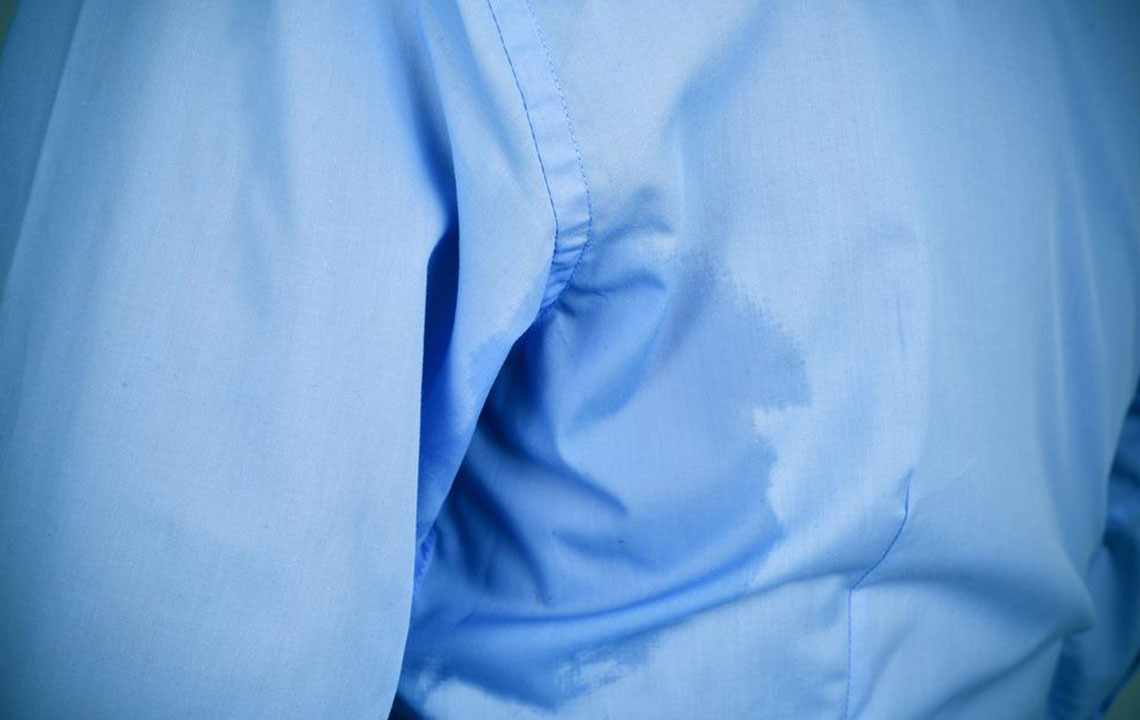Here are Some of the Common Causes Of Excessive Sweating

Hyperhidrosis refers to the medical condition that involves excessive sweating. While everyone does sweat when it’s extremely hot outside, those suffering from hyperhidrosis sweat so profusely, that even water may drip from their hands.
In normal circumstances, perspiration produced by the sweat glands is carried to the surface of the skin when the air temperature rises, when exercising, when feeling nervous or anxious, and when having fever. Once these factors have ceased, the nerves signaling the sweat glands are put on hold. But for those with hyperhidrosis, these sweat glands don’t go into inertia and one sweats even when the surrounding environment is quite cool, as in an air conditioned room.
Hyperhidrosis is classified into two categories:
Primary hyperhidrosis (Focal hyperhidrosis): Excessive sweating caused in specific regions of the body such as the underarms, hands, face and groin, without any apparent reason. It is not a medical condition to be worried about and doesn’t require medication.
Secondary hyperhidrosis (Generalized hyperhidrosis): Excessive sweating caused all over the body and not just one specific region. This is a more serious medical condition, as the reason behind this is basically an underlying medical condition.
The Causes Of Excessive Wweating
The cause of excessive sweating in secondary hyperhidrosis, is mainly caused by an underlying medical condition, which is most likely to be one of the following:
Hyperthyroidism
· When too many thyroid hormones circulate throughout the body, it is called hyperthyroidism.
· The body’s chemical process gets speeded up and this is one of the causes of excessive sweating.
· Medication, surgery and iodine radiation have proved to be effective in its treatment.
Medications
· Some medicines that treat high blood pressure, or some antibiotics and supplements have been known to cause excessive sweating.
· One must consult the doctor if this happens, as one must not stop your prescription medicine without the doctor’s consultation.
Menopause
· Hot flashes experienced by women going through menopause have been noticed to be another cause of excessive sweating.
· As much as seventy five percent of women have experienced hot flushes, causing them to excessively sweat so much, that it even requires change of clothing.
· The decreasing and fluctuating estrogen levels, which drop when the periods stop, are suspected to be the primary cause of excessive sweating.
Psychiatric problems
· One common cause of excessive sweating, has been found to be psychiatric problems such as stress and anxiety.
· Body temperatures tend to rise when experiencing stress and anxiety, and this then causes excessive sweating.
· Excessive sweating also leads to embarrassment, especially when out in a public place, which then leads to further anxiety and thus even more sweating.
· Certain psychiatric drugs have also been found to be the cause of excessive sweating.
Glucose control disorder
· One of the causes of excessive sweating is the abnormally low glucose levels in the human body, called hypoglycaemia.
Cancer
· Hodgkin’s lymphoma, Non-Hodgkin’s lymphoma, leukemia, mesothelioma, carcinoid tumors, liver cancer and bone cancer are certain types of cancers that are known to be the cause of excessive sweating.
· It has still not been understood by doctors as to why certain cancers cause excessive sweating. Though it may have a relation with the body’s efforts to fight the cancer.
· Those in the advanced stages of cancer of any type, also tend to experience excessive sweating.
Pregnancy
· Women tend to battle excessive sweating during their entire reproductive lifespan.
· Pregnancy too, is known to be one of the causes of excessive sweating.
· The body’s temperature tends to rise due to the increase in blood flow, caused by changing hormone levels.
Nicotine and other drugs
· Nicotine has been found to be another cause of excessive sweating.
· When smoking, the inhalation of nicotine causes the body to release certain chemicals, one of which is acetylcholine. This chemical triggers the sweat glands and with excessive smoking, and the constant accumulation of this chemical in the body, persistent sweating takes place.
· Another cause of excessive sweating has been found to be the withdrawal symptoms from a number of illegal and legal substances, such as opiates and alcohol or drugs.
Some other known, but not so prevalent causes of excessive sweating are:
· Obesity
· Parkinson’s disease
· Rheumatoid arthritis
· Gout
· Infection
Treatment For Excessive Sweating
While primary focal hyperhidrosis may not have a cure, there are methods to help control the symptoms, which include:
- Using antiperspirants in the form of over the counter, or prescription lotions, sprays and roll-ons.
- A treatment called Iontophoresis that uses low electrical impulses to disable the sweat glands temporarily.
- The usage of medications that prevent the sweat glands from being triggered.
Secondary hyperhidrosis can be treated by addressing the medical condition causing it, such as treating an overactive thyroid by medication, or in the case of diabetes, ensuring that the glucose levels are under control, that will automatically cease the excessive sweating.
While in some cases the medical condition may not be cured, one can directly try to prevent excessive sweating. Any such treatment for treating the cause of excessive sweating must always be started only after consulting a medical professional.


